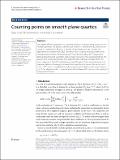| dc.contributor.author | Costa, Edgar | |
| dc.contributor.author | Harvey, David | |
| dc.contributor.author | Sutherland, Andrew V. | |
| dc.date.accessioned | 2022-11-28T15:34:32Z | |
| dc.date.available | 2022-11-28T15:34:32Z | |
| dc.date.issued | 2022-11-21 | |
| dc.identifier.uri | https://hdl.handle.net/1721.1/146631 | |
| dc.description.abstract | Abstract
We present efficient algorithms for counting points on a smooth plane quartic curve X modulo a prime p. We address both the case where X is defined over
$${\mathbb {F}}_p$$
F
p
and the case where X is defined over
$${\mathbb {Q}}$$
Q
and p is a prime of good reduction. We consider two approaches for computing
$$\#X({\mathbb {F}}_p)$$
#
X
(
F
p
)
, one which runs in
$$O(p\log p\log \log p)$$
O
(
p
log
p
log
log
p
)
time using
$$O(\log p)$$
O
(
log
p
)
space and one which runs in
$$O(p^{1/2}\log ^2p)$$
O
(
p
1
/
2
log
2
p
)
time using
$$O(p^{1/2}\log p)$$
O
(
p
1
/
2
log
p
)
space. Both approaches yield algorithms that are faster in practice than existing methods. We also present average polynomial-time algorithms for
$$X/{\mathbb {Q}}$$
X
/
Q
that compute
$$\#X({\mathbb {F}}_p)$$
#
X
(
F
p
)
for good primes
$$p\leqslant N$$
p
⩽
N
in
$$O(N\log ^3 N)$$
O
(
N
log
3
N
)
time using O(N) space. These are the first practical implementations of average polynomial-time algorithms for curves that are not cyclic covers of
$${\mathbb {P}}^1$$
P
1
, which in combination with previous results addresses all curves of genus
$$g\leqslant 3$$
g
⩽
3
. Our algorithms also compute Cartier–Manin/Hasse–Witt matrices that may be of independent interest. | en_US |
| dc.publisher | Springer International Publishing | en_US |
| dc.relation.isversionof | https://doi.org/10.1007/s40993-022-00397-8 | en_US |
| dc.rights | Creative Commons Attribution | en_US |
| dc.rights.uri | https://creativecommons.org/licenses/by/4.0/ | en_US |
| dc.source | Springer International Publishing | en_US |
| dc.title | Counting points on smooth plane quartics | en_US |
| dc.type | Article | en_US |
| dc.identifier.citation | Research in Number Theory. 2022 Nov 21;9(1):1 | en_US |
| dc.contributor.department | Massachusetts Institute of Technology. Department of Mathematics | |
| dc.identifier.mitlicense | PUBLISHER_CC | |
| dc.eprint.version | Final published version | en_US |
| dc.type.uri | http://purl.org/eprint/type/JournalArticle | en_US |
| eprint.status | http://purl.org/eprint/status/PeerReviewed | en_US |
| dc.date.updated | 2022-11-27T04:12:35Z | |
| dc.language.rfc3066 | en | |
| dc.rights.holder | The Author(s) | |
| dspace.embargo.terms | N | |
| dspace.date.submission | 2022-11-27T04:12:35Z | |
| mit.license | PUBLISHER_CC | |
| mit.metadata.status | Authority Work and Publication Information Needed | en_US |
